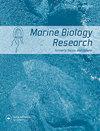Latitudinal distribution of skeleton shrimps (Amphipoda, Caprellidae) in artificial habitats throughout the eastern South Pacific coast of Peru
IF 1.2
4区 生物学
Q4 ECOLOGY
引用次数: 0
Abstract
ABSTRACT Biodiversity tends to decrease poleward and increase towards the equator. However, these patterns remain unknown for many invertebrate taxa throughout Peru's eastern South Pacific coast, particularly for caprellid crustaceans which are conspicuous in artificial habitats. Three biogeographical units have been proposed for the Peruvian coast: Panamic and Humboldt provinces with a transition zone in between, but a few invertebrates support this classification. We evaluated if the diversity of caprellids decreases towards high latitudes and if the assemblages of caprellids depicted the biogeographic zonation proposed for the Peruvian coast. From 15th to 31st October 2021, caprellids were collected from biofouling communities colonizing boat hulls, buoys, and ropes throughout the Peruvian coast (3.74°–17.99° S). The caprellid assemblage consisted on six species: Caprella penantis [sensu lato], C. penantis f. gibbosa, C. equilibra, C. scaura, Paracaprella pusilla, and Deutella venenosa. Overall, caprellids' abundance, species richness, and diversity decreased southwards. Specific caprellid assemblages showed affinities for each of the three biogeographical units. The dissimilarity of the caprellid assemblages increased at approximately every one degree of latitude. Although artificial substrates can alter biodiversity patterns, caprellids showed the canonical pattern of high diversity towards the equator and resembled the biogeographic zonation proposed for the Peruvian coast.秘鲁南太平洋东部沿海人工生境中骨虾(片足目,骨虾科)的纬度分布
本文章由计算机程序翻译,如有差异,请以英文原文为准。
求助全文
约1分钟内获得全文
求助全文
来源期刊

Marine Biology Research
生物-海洋与淡水生物学
CiteScore
2.10
自引率
0.00%
发文量
55
审稿时长
6-12 weeks
期刊介绍:
Marine Biology Research (MBRJ) provides a worldwide forum for key information, ideas and discussion on all areas of marine biology and biological oceanography. Founded in 2005 as a merger of two Scandinavian journals, Sarsia and Ophelia, MBRJ is based today at the Institute of Marine Research, Bergen, Norway. The Journal’s scope encompasses basic and applied research from all oceans and marine habitats and on all marine organisms, the main criterium for acceptance being quality.
 求助内容:
求助内容: 应助结果提醒方式:
应助结果提醒方式:


